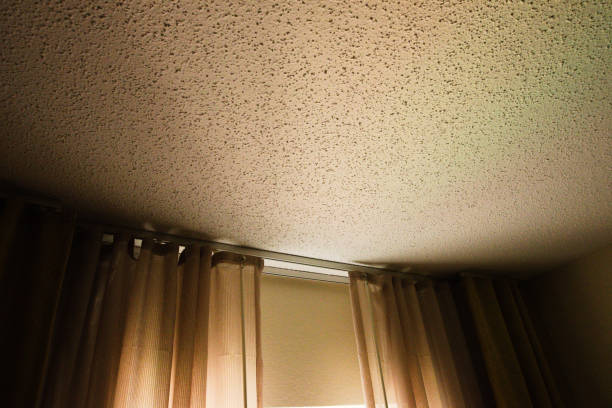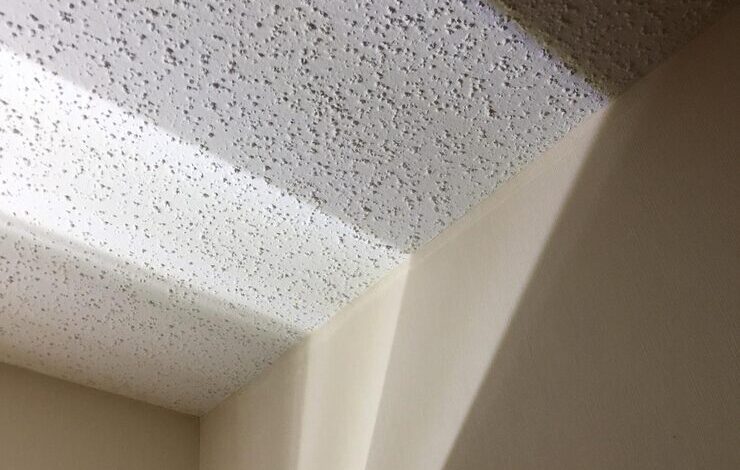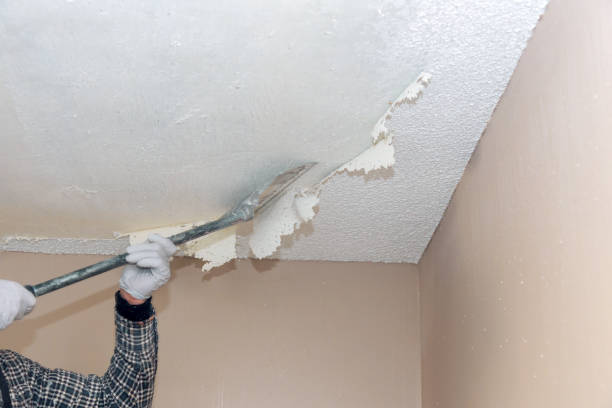Menu

If you’ve ever looked up at your ceiling and thought, “What is that bumpy texture?” — you’re not alone.
Popcorn ceilings were once the height of home design convenience, but today, they’re a point of confusion and concern for many homeowners. Homeowners often wonder, do popcorn ceilings have asbestos, and what that means for their family’s safety.
Whether you’re wondering what a popcorn ceiling is, why it’s bad, or if it might contain asbestos, understanding what’s above you is the first step to a safer, cleaner, and more modern home.
✔ Popcorn ceilings were popular for hiding flaws and reducing noise but are now considered outdated.
✔ Many older popcorn ceilings may contain asbestos and require professional testing.
✔ You can’t tell if a popcorn ceiling has asbestos just by looking—lab testing is the only way.
✔ Asbestos popcorn ceilings should never be scraped or painted without professional help.
✔ Hiring interior house painters near me ensures safe, modern, and high-quality ceiling updates.
A popcorn ceiling—sometimes called an acoustic ceiling or cottage cheese ceiling—was a common design trend from the 1950s through the 1980s. Builders loved it because it was inexpensive, quick to apply, and great for hiding imperfections.

A popcorn ceiling has a textured, clumpy surface that resembles popcorn or cottage cheese. It’s usually white or off-white and found in hallways, bedrooms, and older living spaces across Connecticut and the U.S.
The texture feels rough and uneven. While it softens sound, it also traps dust, cobwebs, and shadows—making rooms look darker and harder to clean.
Contractors sprayed a mixture of drywall compound and lightweight particles (like Styrofoam or vermiculite) onto a flat ceiling. The technique saved time and labor compared to hand-troweled plaster.
Popcorn ceilings were practical: they concealed flaws, absorbed sound, and diffused light. Over time, though, many homeowners realized that convenience came with drawbacks—especially when asbestos was involved.
Before the late 1970s, many popcorn ceilings were made with asbestos, a mineral prized for fire resistance and durability. Later versions used safer materials such as Styrofoam, paper fiber, or mineral fillers.
If your home was built before 1980, it’s wise to assume the ceiling might contain asbestos until professional testing confirms otherwise.
If you’re unsure is there asbestos in popcorn ceilings built before 1980, professional testing is the only way to know.
Homeowners often ask, “Does popcorn ceiling have asbestos?” The answer depends on when it was applied. Older ceilings—especially those installed before 1980—commonly included asbestos. This type of asbestos popcorn ceiling vs non-asbestos ceiling looks identical to the untrained eye, which is why professional testing is essential.
Asbestos fibers can become airborne if disturbed, which is why experts advise leaving the ceiling untouched until it’s tested. If you’ve ever asked, do popcorn ceilings have asbestos, the answer depends on your home’s age and materials used.
Many homeowners ask, is there asbestos in popcorn ceilings, but no visual inspection can confirm it—only lab testing.
Knowing whether you have an asbestos popcorn ceiling vs non-asbestos one determines the safest next steps—testing, encapsulation, or removal.
Avoid scraping or sanding the surface yourself. Even a small disturbance can release fibers. Instead, hire a certified asbestos testing company or work with professional painters who coordinate safe sampling and testing. Professional asbestos testing typically costs around $480 on average in the United States.
Many homeowners ask, “Why is popcorn ceiling bad?” or “Is popcorn ceiling bad for my home?” There are several reasons:
While not all popcorn ceilings are dangerous, their downsides often outweigh their benefits.
Homeowners often ask, why is popcorn ceiling bad—and the answer usually involves appearance, health, and maintenance concerns.
If the ceiling is intact, yes—it’s generally safe. Problems arise when the texture cracks, peels, or is disturbed during remodeling. Damaged surfaces may release asbestos fibers into the air.
Even if you suspect there is asbestos in popcorn ceilings, it’s generally safe if the surface is intact and undisturbed.
For peace of mind, homeowners in Westport, CT, should schedule a professional inspection before starting any interior projects. Interior house painters near me who specialize in older homes can help determine if the ceiling needs testing or removal.
Painting can safely encapsulate asbestos fibers, but it’s not a DIY project. Rolling, scraping, or sanding can cause exposure. Only trained professionals should paint or seal an asbestos ceiling.
If testing shows your popcorn texture contains asbestos, encapsulation can be a short-term solution—but full removal is usually best for long-term safety and aesthetics. Qualified interior house painters near me can handle either option with proper equipment and safety measures.
When dealing with popcorn ceilings, especially those that may contain asbestos, experience matters. Professional painters:
Hiring local experts ensures both your safety and the quality of your results. If you’re unsure and asking yourself, do popcorn ceilings have asbestos, our team can coordinate safe testing before any refinishing.

It’s not safe, especially if it’s an asbestos popcorn ceiling. Hire certified interior house painters near me or abatement experts to handle removal properly.
Costs depend on ceiling size and whether asbestos popcorn ceiling materials are present. Get a quote from local interior house painters near me after testing.
Painting can seal an asbestos popcorn ceiling, but it doesn’t remove the hazard. Only professionals should safely encapsulate or remove it.
Yes. A non-asbestos popcorn ceiling is safe—it’s mostly an aesthetic issue. Many homeowners hire interior house painters near me to modernize the look.
Smooth or lightly textured finishes like knockdown are popular. Skilled interior house painters near me can refinish your popcorn ceiling for a clean, updated style.
If you’ve discovered why popcorn ceiling is bad for your home, now’s the time to schedule a safe and stylish upgrade. We’ll help you determine whether your ceiling in Westport, CT, is safe, recommended the best refinishing method, and deliver a beautifully smooth result you’ll love.
Contact Westport Professional House Painters today for a consultation.